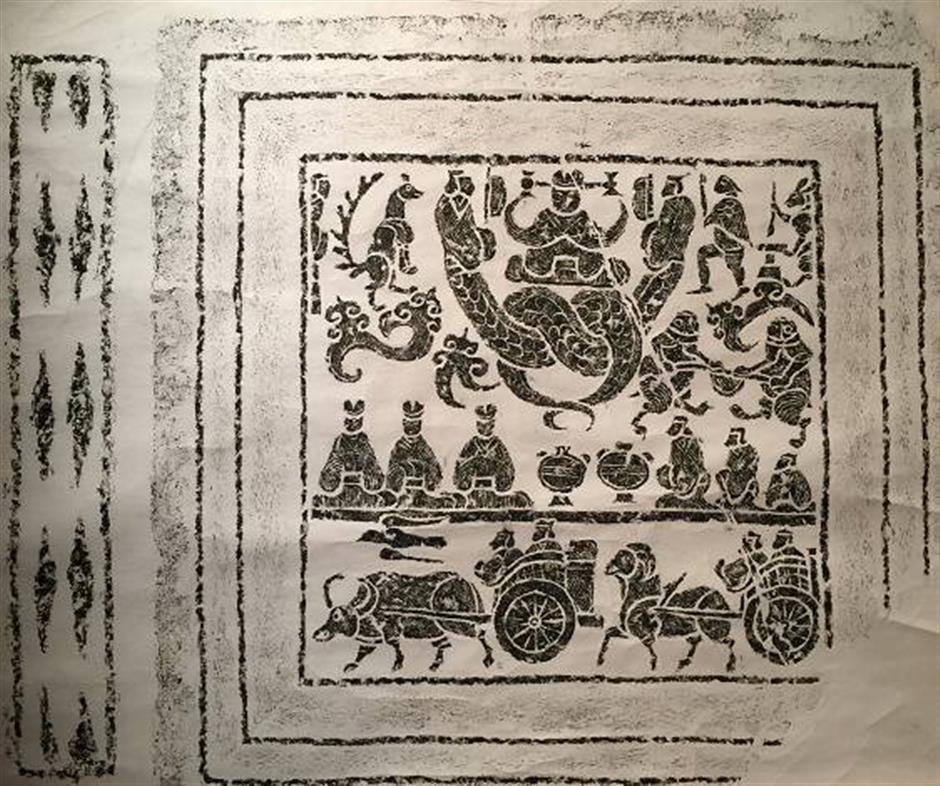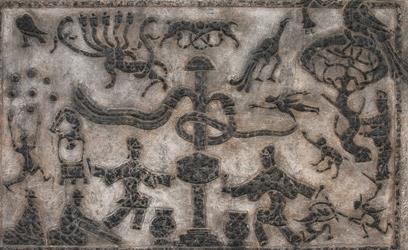Rare stone inscriptions chronicle historical and cultural past

The stone relief rubbing featuring Fuxi and Nuwa is one of the highlights at the Luxun Museum. The rubbing provides a vivid and informative image of how humans were created.
A rare collection of rubbings from Han Dynasty carved stones in Tengzhou, east China’s Shandong Province, is on display at the Shanghai Luxun Museum until January 21.
There is probably no other civilization than Chinese in the world which relied on carving inscriptions into stone as a way of preserving the memory of its history and culture. Records of important events were inscribed on bones and bronze as early as the Han Dynasty (206 BC-AD 220).
Brick, tile, ceramics, wood and jade were also engraved to preserve writings and pictorial representations. But the medium most used for long inscriptions was stone.
Tengzhou was the regional center of politics, economy and culture during the Han Dynasty. Many stone inscriptions unearthed from the tomb chambers and family temples in Tengzhou have superbly chronicled the local customs, festive events and historical campaigns from that period, as well as some of the teachings of the great philosopher Confucius, who was born in the state of Lu, the present-day Shandong Province.
Among the 55 sets of rubbings at the Shanghai exhibition, one of the highlights is a stone relief featuring the story of Fuxi and Nuwa. According to Chinese mythology “Classic of Mountains and Seas,” Fuxi and Nuwa were the original humans who lived on the mythological Kunlun Mountain, which is today’s Huashan Mountain.
One day, Fuxi and Nuwa created two separate fires but they eventually became one. So under the fire, they decided to become husband and wife and used clay to create offspring. With their divine power they made the clay figures come to life.
In the rubbing, visitors will find Fuxi and Nuwa sitting on either side of Xi Wangmu with their lower part of the body twined together in the form of a snake. Xi Wangmu was Queen Mother of the West, and also known as a goddess in charge of the life and death of all deities in the universe.
Based on the text, Fuxi established this marriage ritual in his tribe. He taught his people how to cook, fish with nets and hunt with weapons made of bone, wood, or bamboo.
In addition to the rubbings from Tengzhou, the museum is also presenting some of the carved stone rubbings collected by Lu Xun (1881-1936), a leading figure of modern Chinese literature.
As a pioneer in modern woodcut movement in the early 20th century in Shanghai, Lu encouraged many young artists to learn from the ancient Chinese rubbings to express their thoughts.
Exhibition details
Date: Through January 21 (closed on Mondays), 9am-4pm
Venue: Shanghai Luxun Museum
Address: 200 Tian’ai Rd

A stone relief depicts a festive event with music and dance during the Han Dynasty from the Tengzhou Museum of Han Stone Reliefs.

Part of a stone relief rubbing features Confucius meeting with Laozi in 518 BC.
















